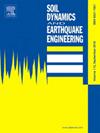采用喷射混凝土法改造的受限砌体学校建筑的抗震性评估
IF 4.2
2区 工程技术
Q1 ENGINEERING, GEOLOGICAL
引用次数: 0
摘要
伊朗 89% 以上的学校(10.7 万所学校,56.3 万间教室)都是用砌体建造的,本研究解决了伊朗砌体学校改造的迫切需求。这项研究以抗震性能评估为重点,具有极其重要的意义,因为这些学校的现状对数百万学生的安全构成了重大威胁。如果不进行适当的评估,后果可能是灾难性的。为了说明这项研究的重要性,我们选择了德黑兰的一所封闭式砌体学校作为代表性案例。计算了抗震指数,考虑了 50 年期间的两个危险等级(2 % 和 10 %),以及近断层脉冲型地动和非近断层脉冲型地动。此外,还对改造后的结构进行了建模比较分析,包括在墙体上喷射混凝土,以评估改造的益处。抗震指数由考虑到可能发生的灾害和恢复过程的分析函数得出,可作为结构脆弱性的综合衡量标准。通过这一评估,可以对封闭式砌体学校的改造和修复获得有价值的见解。这项研究的结果将有助于在减轻类似结构的地震风险方面做出明智的决策。总之,本文表明,在砌体墙体上喷射混凝土可以大大提高效率,因为建筑物的回弹指数和功能性都有显著提高。此外,改造后建筑物的损坏程度减半,脆性曲线也证明了这一点,在较高的漂移率下表现更佳。本文章由计算机程序翻译,如有差异,请以英文原文为准。
Seismic resilience evaluation of confined masonry school buildings retrofitted by shotcrete method
This study addresses the urgent need for retrofitting masonry schools in Iran, where over 89 % of schools are constructed using masonry (107000 Schools consisted of 563000 classrooms). Focusing on seismic performance evaluation, this research is of paramount importance as the current state of these schools poses a significant risk to the safety of millions of students. Without proper evaluation, the consequences could be catastrophic. To illustrate the significance of this study, a confined masonry school in Tehran was selected as a representative case study. The seismic resilience index was calculated, considering two hazard levels (2 % and 10 %) over a 50-year period, with and without near-fault pulse-type ground motions. Furthermore, a comparative analysis was conducted by modeling the retrofitted structure, which involved the application of shotcrete on walls, to assess the benefits of retrofitting. The seismic resilience index, derived from analytical functions that account for probable hazards and the recovery process, serves as a comprehensive measure of the structure's vulnerability. Through this evaluation, valuable insights into the retrofitting and rehabilitation of confined masonry schools can be gained. The results obtained from this research will aid in informed decision-making regarding the mitigation of seismic risks in similar structures. In conclusion, this paper indicates applying shotcrete to masonry walls can be substantially efficient as the resilience index and functionality of the building increases by a significant margin. Furthermore, the building damage was halved after the retrofitting operation and fragility curves admit it by showing better performance in higher drift ratios.
求助全文
通过发布文献求助,成功后即可免费获取论文全文。
去求助
来源期刊

Soil Dynamics and Earthquake Engineering
工程技术-地球科学综合
CiteScore
7.50
自引率
15.00%
发文量
446
审稿时长
8 months
期刊介绍:
The journal aims to encourage and enhance the role of mechanics and other disciplines as they relate to earthquake engineering by providing opportunities for the publication of the work of applied mathematicians, engineers and other applied scientists involved in solving problems closely related to the field of earthquake engineering and geotechnical earthquake engineering.
Emphasis is placed on new concepts and techniques, but case histories will also be published if they enhance the presentation and understanding of new technical concepts.
 求助内容:
求助内容: 应助结果提醒方式:
应助结果提醒方式:


